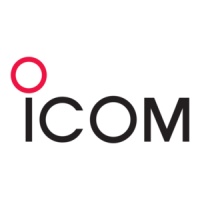18
8
ABOUT CE
• Typical installation example
A UHF base station transmitter is to be installed on the
roof of an office.
The transmit power is 25 watts, there is 20 m of RG-
213 coaxial cable and the antenna is vertically po-
larised dipole.
The specification of the RG-213 cable gives a loss of
1.5 dB/10 m. There will be 3 dB loss for the 20 m
length used.
The RF power at the antenna input will be 12.5 watts.
The dipole antenna has a forward gain of 0 dBd or 1.6,
giving an EIRP of 20 watts.
Referring to the table above for VHF/UHF vertical an-
tennas, this gives a front clearance distance of approx.
1.5 m and a height clearance of 3 m.
The antenna installation needs to ensure that the low-
est part of the antenna is at least 3 m above any point
where the general public may gain access and that
they cannot pass within 1.5 m in front of the antenna.
If there is no general public access to the roof in ques-
tion then the antenna could be mounted on a short
stub mast. If there is such access to the roof then the
antenna could be mounted on top of a short mast of
3.2 m high. The mast position should be such that the
antenna can radiate clearly i.e. no other object or
structure is within 1.5 m (preferably more).
It should be relatively easy to fulfil all these recom-
mendations.
If for any reason such minimum distances are impos-
sible to guarantee then some type of access control
fence or barrier around the antenna installation should
be provided.
Should a Yagi type antenna be used then you will have
to obtain a 3 dimensional polar plot of the radiation
characteristic from the manufacturer and evaluate the
clearance distances in both vertical and horizontal
planes.
• Operating Notes
All of the above comments on RF safety assume that
the radio is transmitting continuously in a constant car-
rier mode such as FM or RTTY etc.
The RF exposure limits recommended by the EC are
based on the mean power averaged over a 6 minute
period.
Therefore if the total transmit time during any 6 minute
period is reduced, then the installation will be even fur-
ther within the recommended limits.
Similarly, not all operating modes are constant carrier.
AM type modes all have a lower mean power level.
Use of SSB or CW will reduce exposure by approxi-
mately 70% for this reason.
CE Versions of the IC-FR3100/FR4100
which display the “CE” symbol on the serial
number seal, comply with the essential re-
quirements of the European Radio and
Telecommunication Terminal Directive
1999/5/EC.
This warning symbol indicates that this
equipment operates in non-harmonised
frequency bands and/or may be subject to
licensing conditions in the country of use.
Be sure to check that you have the correct
version of this radio or the correct pro-
gramming of this radio, to comply with na-
tional licensing requirement.

